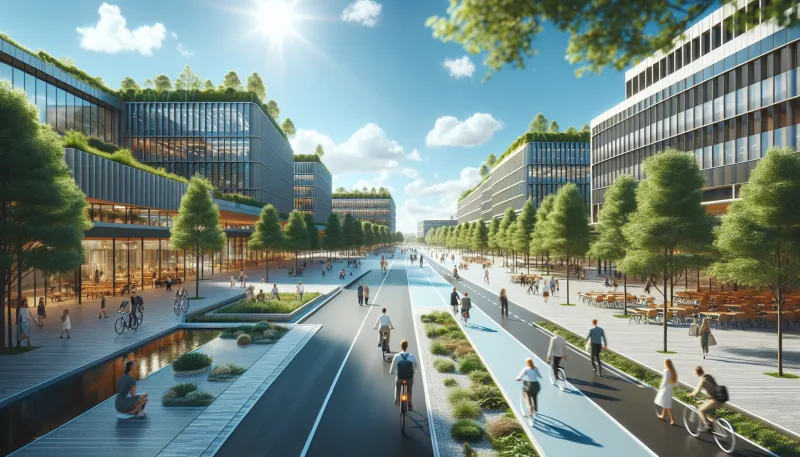
How public-private partnerships transform urban development
Urban development is an intricate process involving various stakeholders and complex challenges. Public-private partnerships (PPPs) have emerged as a vital mechanism to drive urban regeneration, infrastructure enhancement, and sustainable growth. This article explores the multifaceted roles PPPs play in shaping the cities of tomorrow, highlighting their benefits, challenges, and strategic importance.
- Defining public-private partnerships in urban contexts
- Driving infrastructure development through collaboration
- Enhancing urban regeneration and revitalization
- Promoting sustainable and smart city initiatives
- Balancing risk and reward between stakeholders
- Challenges in implementing successful PPP projects
- Case studies illustrating PPP impact on cities
- The role of policy and regulation in PPP effectiveness
- Future trends shaping PPPs in urban development
Defining public-private partnerships in urban contexts
Public-private partnerships refer to collaborative agreements between government entities and private sector companies to finance, build, and operate urban projects. These partnerships leverage the strengths of both sectors — the public sector's regulatory and planning authority, alongside the private sector's efficiency, innovation, and capital. In urban development, PPPs are widely used to address infrastructure gaps, improve service delivery, and stimulate economic growth.
Driving infrastructure development through collaboration
One of the primary roles of PPPs in urban areas is to facilitate large-scale infrastructure projects such as transportation networks, water systems, and energy grids. Governments often face budget constraints, and partnering with private firms enables the mobilization of private investment to fill funding gaps. This collaboration accelerates project timelines and ensures quality delivery by combining public oversight with private sector expertise.
Enhancing urban regeneration and revitalization
PPPs play a pivotal role in urban regeneration projects, revitalizing blighted neighborhoods and underutilized spaces. Through shared investment and risk, these partnerships attract developers and investors to undertake ambitious projects that would otherwise be unfeasible. By integrating commercial, residential, and public spaces, PPPs help create vibrant, mixed-use communities that meet modern urban demands.
Promoting sustainable and smart city initiatives
Modern urban development increasingly focuses on sustainability and technology integration. PPPs facilitate the deployment of smart infrastructure, such as intelligent transportation systems, energy-efficient buildings, and waste management solutions. The private sector’s capacity for innovation complements public goals to reduce environmental impact and enhance urban livability.
Balancing risk and reward between stakeholders
Effective PPPs require carefully negotiated terms that balance risk and reward between public and private partners. Typically, the private sector assumes construction and operational risks, while the public sector handles regulatory and political risks. This balance ensures accountability and incentivizes high performance. Transparent contracts and clear governance structures are essential for managing this relationship.
Challenges in implementing successful PPP projects
Despite their advantages, PPPs face challenges including complex negotiations, long development timelines, and potential public opposition. Conflicting objectives between profit-driven private firms and public interest goals can create tension. Additionally, ensuring equitable access and affordability within PPP projects remains a critical concern, requiring careful planning and stakeholder engagement.
Case studies illustrating PPP impact on cities
Several cities worldwide demonstrate how PPPs successfully shape urban development. For example, the regeneration of the London Docklands involved extensive private investment under public guidance, transforming industrial wastelands into economic hubs. Similarly, transportation networks like Hong Kong’s Mass Transit Railway are successful PPPs delivering efficient urban mobility. These case studies showcase best practices and lessons learned.
The role of policy and regulation in PPP effectiveness
Government policies and regulatory frameworks critically influence PPP effectiveness. Clear, consistent regulations encourage private sector participation by reducing uncertainty. Policies promoting transparency, competitive bidding, and environmental standards strengthen the partnership’s integrity. Moreover, supportive legislation enables innovative financing models and risk-sharing mechanisms that broaden PPP applicability.
Future trends shaping PPPs in urban development
As urban challenges evolve, future PPPs are expected to incorporate emerging technologies like artificial intelligence, Internet of Things (IoT), and green infrastructure solutions. Increased emphasis on community participation and social impact metrics will shape project design and implementation. Moreover, hybrid partnership models including non-profits and academic institutions alongside public and private players may become more common, fostering holistic urban solutions.
Tommy is a property-passionate journalist who covers the forces shaping housing and the built environment. With a data-driven approach and a reporter’s curiosity, he writes on market cycles, urban development, PropTech, and policy—always connecting numbers to everyday lives. [Name]’s work blends clear analysis with on-the-ground reporting to help readers navigate trends, opportunities, and risks across residential and commercial real estate.












